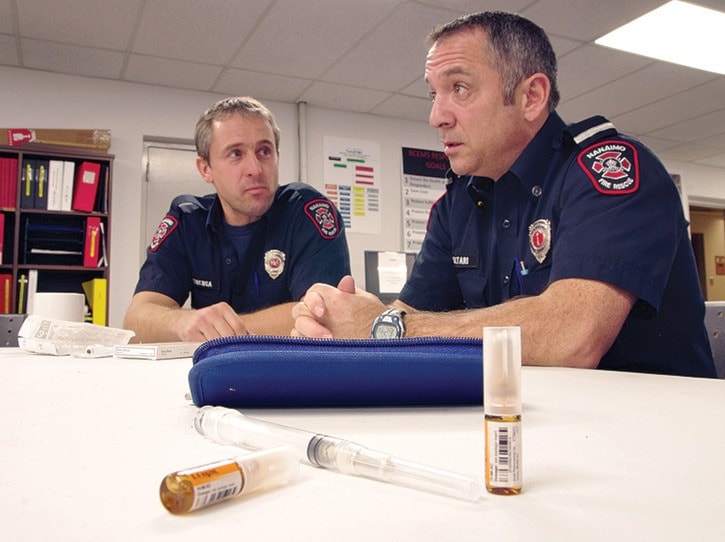When a Nanaimo man went missing earlier this year, it was his family that eventually found him in the crawlspace of their home, dead from an overdose of fentanyl.
According to firefighters who attended, the family had no idea he was a heroin user.
Of 5,467 medical assistance calls Nanaimo Fire Rescue responded to by the end of November, 245 of those were overdoses. The man found by his family was one of 25 people who died by overdose by the end of November in Nanaimo, according to statistics released by B.C. Coroners Service Monday.
Fentanyl, essentially synthetic heroin, and its derivatives created to control pain, appeared in Nanaimo street drugs in late 2012. The opioid’s high potency increases risk of overdose that makes it equally deadly for experienced and first-time recreational users.
“People think it's not going to happen to them,” said Capt. Bryun Ashlie, of Nanaimo Fire Rescue, recalling a first-time user who overdosed. “As soon as you get in there you're done. You're basically in respiratory arrest."
Fentanyl suppresses the respiratory system. First responders can instantly revive victims with Narcan, also known as Naloxone, to reverse its effects, but only for about 30 to 60 minutes, so getting to a hospital is critical because when Narcan wears off the patient can go back into overdose.
Getting high with a friend who can call 911 also isn’t a reliable safety measure.
"The guys were saying the other night they had a double OD," said Lieut. Dan Multari. "I don't know if it was boyfriend/girlfriend, but they both OD'd laying in the bed together."
Ashlie said Naloxone is a band-aid solution possibly sending drug users the false message they can always be saved.
"We've been to people who have actually overdosed three days in a row," said Ashlie.
Addictions medicine specialist Dr. Paddy Mark, who works with patients at Nanaimo’s Aids Vancouver Island Clinic, Nanaimo Correctional Centre and is an addictions support doctor at Nanaimo Regional General Hospital, said emergency workers are catching overdoses faster, but overdoses are becoming more frequent and she expects the situation will get worse before it gets better.
“We’ve got not only fentanyl, but carfentanil and all the other analogues of fentanyl, which will be showing up and we do not have nearly enough front-line people to offer the hands-on help to get people into some kind of treatment,” Mark said.
She describes three kinds of addicts: those using to avoid emotional pain of severe childhood trauma; youthful experimenters; and patients who became addicted to pain killers, such as Oxycontin, promoted by drug companies and over-prescribed by doctors.
The addicted homeless are the most vulnerable, she said. Mark advocates for safe, low-cost housing where addicts improve recovery odds by living away from substance abusers.
“Having a roof over your head that is safe and clean – not drug-ridden – is a big thing,” Mark said. “Most of the patients living on the street, if they do get shelter, it’s not good shelter.”
She also wants fully-funded addiction treatment. Patients pay to attend the AIDS health clinic. Heroin is cheaper than methadone, which is prescribed to avert withdrawal symptoms. It means patients, already economically disadvantaged by their addictions, will risk taking street drugs, such as fentanyl.
Cpl. Dave LaBerge, head of Nanaimo RCMP’s Bike Patrol Unit, said fentanyl is the current drug of choice on the street for users “chasing that high they got from the first time they took heroin” and stronger variants – many coming from China – require more doses of Naloxone to counter their effects. Narcan kits now contain three vials.
“The stuff is so strong, I mean people need four, five, six shots of Naloxone before they’re going to revive – if they do,” LaBerge said. “It’s getting tougher and tougher.”
Of 755 overdose deaths province-wide, so far, in 2016, fentanyl was linked to 374.
All drug users, be they recreational or long-term, are at risk, he said.
Overdoses now kill more people in B.C. annually than car accidents, said Dr. Paul Hasselback, central Island medical health officer, who estimates Nanaimo Regional General Hospital will see up to 450 overdoses for 2016, up nearly 50 per cent from 2015.
An estimated 1,700 people use heroin in greater Nanaimo.
“Nanaimo certainly saw it earlier and continues to see a higher proportion of fatalities where fentanyl has been identified,” Hasselback said.
Fentanyl has unveiled the extent of drug use, its sensitivity to minor changes in the drug supply and the need for better prevention and treatment options.
“We need to be talking supervised consumption, so we can develop trusting relationships and allow users … to have a bit more faith in the system that they will get some support and be supported in what lifestyle changes they may want to make. We’ve got to be there when the time comes when they do want to make some changes,” Hasselback said.
